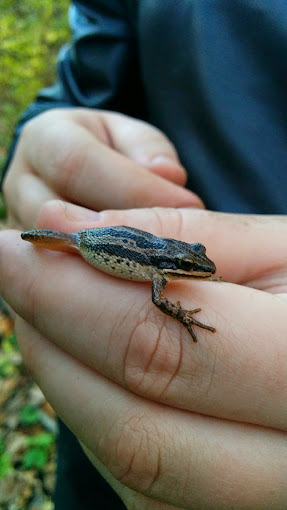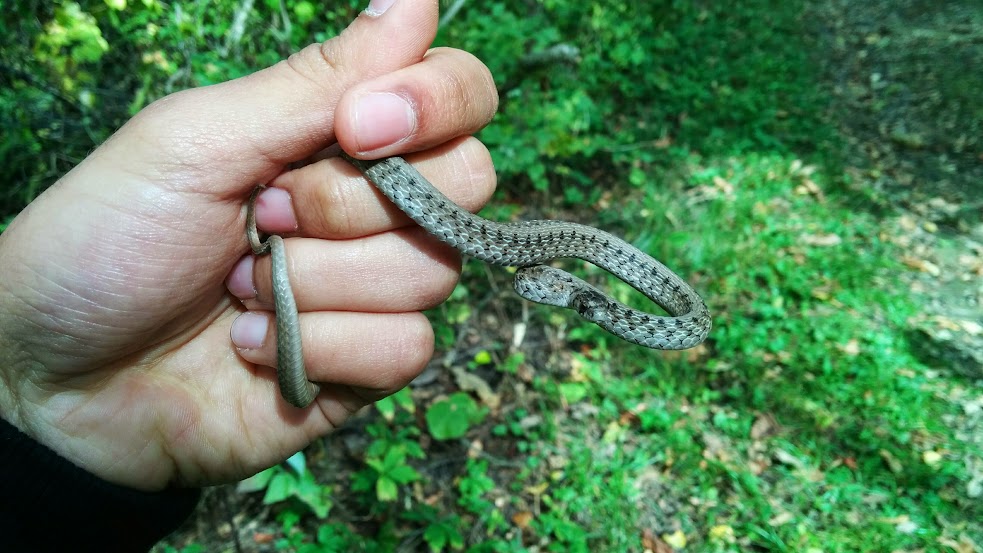 |
| Juvenile Blue Racer: PC Yatin Kalki |
Date:
October 25th 2014
Species Found
- Red Back Salamander (Plethodon cinereus)
- Northern Slimy Salamander (Plethodon glutinosus)
- Southern Two Lined Salamander (Eurycea cirrigera)
- Wood Frog (Lithobates sylvaticus)
- Northern Spring Peeper (Pseudacris c. crucifer)
- Western Chorus Frog (Pseudacris triseriata)
- Blue Racer (Coluber constrictor foxii)
- Four Toed Salamander (Hemidactylium scutatum)
- Northern Cricket Frog (Acris crepitans blanchardi)
Background:
It was getting colder and we thought the snake season was just about over. We decided to concentrate more on salamanders as they have higher tolerance to the cold. Tristan found 'Doug' on Flickr who had found a variety of salamander species in a neighboring county. He reached out to Doug and it turned out that Doug worked at the University of Illinois in the chemistry department. Doug agreed to take me, Tristan and Megan out to Vermilion County and show us some of the salamander spots.
The Trip:
Doug first took us to a place where he had found Marbled Salamanders before. We had no luck there though. Then, we all branched out from that spot, herping in different directions, just to see what we might find. I found several slugs, earthworms, centipedes and wolf spiders but no herps. After what seemed like an hour, Tristan yelled that he had found something. He was really far away so his voice was really faint. I walked some distance just following his voice and when I finally found him, he showed me two small Red Back Salamanders that he had in his hand. They were dark colored with a reddish stripe running down their back. They looked quite similar to the Zigzag Salamanders we had seen at Snake Road.
 |
| Red Back Salamander: PC Yatin Kalki |
 |
| Red Back Salamander: PC Yatin Kalki |
We then moved on to another location: a hillside with a lot of rocks to flip. There we found at least 100 more Red Back Salamanders. Some of the Red Backs didn't have the stripe running down their back. These were apparently called Lead Backs but they were the same species as the Red Backs. They were just a different phase. The Red/Lead Backs ranged in size from 5 cm to 8 cm.
 |
| Red Back Salamander: PC Tristan Schramer |
 |
| Lead Back Salamander: PC Tristan Schramer |
 |
| Red Back Salamander: PC Tristan Schramer |
 |
| Both phases: PC Tristan Schramer |
We also found some Red Back neonates (babies). They were barely 2 cm long.
 |
| Red Back Salamander Neonate: PC Tristan Schramer |
Everyone was getting kind of bored of finding only one species over and over. I saw a large flat rock that was kind of breaking off in slates. I flipped it and found 6 Red Backs and one large black salamander that looked differently proportioned than the other ones I had been seeing. I picked it up and called everyone over. Tristan identified it as a Slimy Salamander. It was 10-12 cm long and had small white dots all over it. It left a sticky residue all over my hands, I guess that's where it gets its name from. The Slimy was a first for everyone and I was really proud that I was the one who found it. While Tristan was photographing it, I found 2 more Slimy Salamanders near the same slate rocks.
 |
| Slimy Salamander: PC Tristan Schramer |
 |
| Slimy Salamander: PC Tristan Schramer |
 |
| Slimy Salamander: PC Tristan Schramer |
 |
| Slimy Salamander: PC Tristan Schramer |
 |
| Slimy Salamander: PC Yatin Kalki |
 |
| Slimy Salamanders: PC Yatin Kalki |
The next species we found was the Southern Two Lined Salamander and guess who found it? Me :)
It was about as big as the Red Backs but looked really different. It was golden yellow with 2 lines running down its back. Its underside was bright yellow. I was holding it in my hand as I climbed down the hill toward everyone else and when I got down the salamander wasn't moving and its body was limp. I thought it had died of shock and I felt guilty as hell. I set it down on a rock to examine it and out of nowhere it jumped up and made a dash for a pile of leaves. It was playing dead the whole time!
 |
| Southern Two Lined Salamander: PC Tristan Schramer |
 |
| Southern Two Lined Salamander: PC Tristan Schramer |
 |
| Southern Two Lined Salamander: PC Tristan Schramer |
We also found some frogs. A Wood Frog and a Spring Peeper. The Wood Frog has a dark eye mask and a yellowish underbelly. It can tolerate freezing temperature and over the Winter it freezes completely only to thaw in the Spring. The Spring Peeper looks like a tree frog with large toe pads and a cross on its back.
 |
| Wood Frog: PC Tristan Schramer |
 |
| Wood Frog: PC Tristan Schramer |
 |
| Wood Frog: PC Yatin Kalki |
 |
| Spring Peeper: PC Yatin Kalki |
 |
| Spring Peeper: PC Tristan Schramer |
 |
| Spring Peeper: PC Tristan Schramer |
Next we went to a snake hibernaculum where Doug had found Black Rat Snakes before. I started looking in the cracks between rocks and flipping the loose ones. Tristan walked up a sunny hill and literally less than 10 seconds later, he came down with a juvenile Blue Racer Snake. I had seen the Black Racer but the Blue was new to me. Racers are some of my favorite snakes so I was super excited. Then, Megan went up the hill and 10 seconds later, she came down holding an adult Blue Racer. The adult was around 4 ft long while the juvenile was maybe 3 ft. I was amazed at how easily they had found the snakes so I decided to go up the hill. Unfortunately I didn't find anything but I had a really fun time handling the other two. These light blue scales of these snakes were iridescent in the sunlight.
 |
| Juvenile Blue Racer: PC Yatin Kalki |
 |
| Juvenile Blue Racer: PC Yatin Kalki |
 |
| Adult Blue Racer: PC Yatin Kalki |
At one point the larger Blue Racer got into a feisty mood and started striking at me. It also started vibrating its tail in the leaf litter to simulate the rattle of a rattlesnake.
When we were releasing the Racers on the hill, I heard something moving through the leaves a few meters away from me. It was another Blue Racer with a whiter color than the other 2. I picked it up by its tail and this one was even feistier than the other one. It got me on the wrist but it didn't break the skin. I had enough pictures of Blue Racers so I let this one go without photographing it.
We next went to a place where the State Threatened Four Toed Salamander is found. It was an artificial wetland created to water cattle. As soon as we got there Megan found a Western Chorus Frog, which was a new species for me. We went on flipping rocks and logs and found various Red Backs and Southern Two Lineds. Finally, Megan found the spot where we found about 10 Four Toed Salamanders. They were identified by their spotted underbelly and constriction at the base of the tail. Since they were a threatened species, all of us were excited about them.
 |
| Western Chorus Frog: PC Yatin Kalki |
 |
| Western Chorus Frog: PC Tristan Schramer |
 |
| Four Toed Salamander: PC Tristan Schramer |
 |
| Four Toed Salamander: PC Tristan Schramer |
 |
| Four Toed Salamander: PC Tristan Schramer |
 |
| Four Toed Salamander: PC Tristan Schramer |
 |
| Four Toed Salamander: PC Tristan Schramer |
 |
| Four Toed Salamander: PC Tristan Schramer |
This trip added 8 new species to my Herpedex, putting my total at 37 herp species in America.
















































































